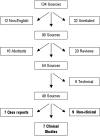Reamer-irrigator-aspirator indications and clinical results: a systematic review
- PMID: 21243358
- PMCID: PMC3167404
- DOI: 10.1007/s00264-010-1189-z
Reamer-irrigator-aspirator indications and clinical results: a systematic review
Abstract
Background: The 'reamer-irrigator-aspirator' (RIA) is an innovation developed to reduce fat embolism (FE) and thermal necrosis (TN) that can occur during reaming/nailing of long-bone fractures. Since its inception its indications have expanded to include the treatment of long-bone osteomyelitis and as a harvester of bone graft/mesenchymal stem cells (MSCs).
Methods: This study involved a systematic review, via Pubmed® and Google Scholar®, of English language sources (nine non-clinical studies, seven clinical studies and seven case reports) using the keywords: 'reamer', 'irrigator', 'aspirator' (1st May 2010). Sources were reviewed with reference to the RIAs efficacy in (1) preventing FE/TN, (2) treating long-bone osteomyelitis, (3) harvesting bone graft/MSCs, and (4) operating safely. Experimental data supports the use of the RIA in preventing FE and TN, however, there is a paucity of clinical data.
Conclusions: The RIA is a reliable method in achieving high volumes of bone graft/MSCs, and high union rates are reported when using RIA bone-fragments to treat non-unions. Evidence suggests possible effectiveness in treating long-bone osteomyelitis. The RIA appears relatively safe, with a low rate of morbidity provided a meticulous technique is used. When complications occur they respond well to conventional techniques. The RIA demands further investigation especially with respect to the optimal application of MSCs for bone repair strategies.
Figures
References
Publication types
MeSH terms
LinkOut - more resources
Full Text Sources
Medical



